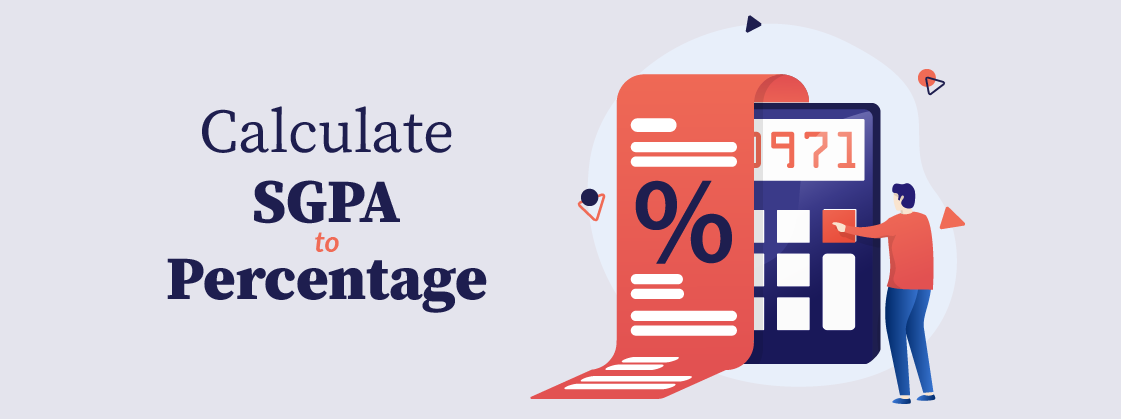How to Calculate SGPA to Percentage?
Table of Contents
Many students often feel confused or are clueless about the CGPA and SGPA grading system. Most universities and institutes use the Semester Grade Point Average (SGPA) for grading students’ performances in a specific semester. But what exactly does a SGPA tell us?
After every semester exam, the student’s academic performance is given an SGPA, which is later converted into CGPA after combining all the SGPAs. While most of the universities follow this grading system, many universities require percentages during the admission process.
In this blog, you will get answers to questions such as “How to calculate SGPA to Percentage?”, “What is the SGPA to Percentage formula?”, and other questions regarding the conversion of SGPA to Percentage.
What is SGPA?
SGPA is a number figure given to students as per their academic performance of one semester. Or you can understand it as the average score of all the subjects that you studied in one semester. Every course that you study has a few credits assigned to it, from which the SGPA is calculated.
Did you know? SGPA is widely accepted in many universities worldwide, especially in technical and engineering courses, making it a crucial metric for academic evaluation.
Usually, an SGPA of 8 or above is considered decent. However, it is essential for students to maintain their high SGPA, as it will lead to an excellent CGPA upon completion of the course.
What are the elements of SGPA?
Understanding the Semester Grade Point Average (SGPA) is essential for students navigating academic evaluations. SGPA quantifies a student’s performance during a specific semester, reflecting their achievements across enrolled courses. The key elements involved in SGPA calculation include:
- Courses and Credits: Each course within a semester is assigned a specific credit value, indicating its weight or importance in the curriculum. Typically, courses with more instructional hours or greater complexity carry higher credit values.
- Grades and Grade Points: Upon course completion, students receive letter grades (e.g., A, B, C) based on their performance. These letter grades correspond to numerical grade points on a standard scale. For instance, an ‘A’ might equate to 9 grade points, a ‘B+’ to 8, and so forth.
- Credit Points: Credit points for each course are calculated by multiplying the course’s credits by the grade points earned. This calculation emphasizes the significance of both the course weight and the student’s performance.
How is SGPA Calculated?
The process of calculating SGPA is simple and general. Read the steps given below to understand the process:
- Make a list of the credits assigned to each Subject.
- Multiply your grades with every subject’s credit.
- Add all these scores.
- Add all the credits of all subjects.
- Divide the total score by total credits.
- That’s it. That is your SGPA.
SGPA to Percentage Conversion Formula
While understanding SGPA is essential, converting it into a percentage is equally important for students who plan to apply to universities or jobs requiring percentage-based scores. The formula to convert SGPA to Percentage is as follows:
Percentage (%) = (SGPA × 10) – 7.5
For Example:
If your SGPA is 8.5, the percentage would be:
(8.5 × 10) – 7.5 = 85 – 7.5 = 77.5%
This formula ensures that your SGPA aligns with percentage calculations used in various academic and professional scenarios. Below are the examples of SGPA to Percentage:-
| SGPA | FORMULA | PERCENTAGE |
| 6.0 | (6*10)-7.5 | 52.5 |
| 6.5 | (6.5*10)-7.5 | 57.5 |
| 7.0 | (7*10)-7.5 | 62.5 |
| 7.5 | (7.5*10)-7.5 | 67.5 |
| 8.0 | (8*10)-7.5 | 72.5 |
How to calculate CGPA from SGPA?
CGPA stands for Cumulative Grade Point Average, which is a single number that determines a student’s academic performance of a year or his/her entire course/degree. The CGPA scale can be a 10-point scale or a 4-point scale.
The formula to calculate CGPA from SGPA is super easy!
All you need to do is calculate the sum of your SGPA of all semesters together. Then, divide that sum by the number of semesters your program had. And there, you have your CGPA.
Let’s see an example:-
| SEMESTER | SGPA |
| SEMESTER 1 | 7 SGPA |
| SEMESTER 2 | 7 SGPA |
| SEMESTER 3 | 9 SGPA |
| SEMESTER 4 | 10 SGPA |
| FORMULA | SUM OF SGPA (33) DIVIDED BY 4 |
| CGPA | 8.25 CGPA |
Global Grading Systems
Grading systems worldwide vary significantly, reflecting cultural, academic, and institutional differences. Below is a comprehensive overview of the global grading systems to help students and professionals better understand their equivalencies and distinctions.
| Country/Region | Grading Scale | Key Notes |
| United States (US) | A: 90–100% (4.0), B: 80–89% (3.0), C: 70–79% (2.0), D: 60–69% (1.0), F: <60% (0.0) | GPA is calculated cumulatively; weighted GPAs for advanced courses are common. |
| United Kingdom (UK) | Undergraduate: 1st (70%+), 2:1 (60–69%), 2:2 (50–59%), 3rd (40–49%), Fail (<40%) | Postgraduate: Distinction (70%+), Merit (60–69%), Pass (50–59%), Fail (<50%). |
| European Union (ECTS) | A (90–100%), B (80–89%), C (70–79%), D (60–69%), E (50–59%), F (<50%) | Standardized system across EU nations; used for academic exchanges like Erasmus+. |
| India | Percentage: 90–100% (A+), 75–89% (A), 60–74% (B+), 50–59% (B), Fail (<50%) | CGPA (10-point scale) widely used; relative grading in IITs and NITs. |
| Australia | HD (85–100%), D (75–84%), C (65–74%), P (50–64%), N (Fail <50%) | Universities also use GPA systems on a 7-point scale. |
| Canada | A+: 90–100%, A: 85–89%, B+: 80–84%, B: 75–79%, F (<50%) | Provincial variations exist (e.g., Quebec uses a 4.3 GPA scale). |
Comparison: CGPA, SGPA & GPA
If you have plans of studying abroad, then these three terms (SGPA, CGPA, GPA) are essential for you to remember. Below is the difference between CGPA, SGPA and GPA:
| CGPA | SGPA | GPA |
| Stands for Cumulative Grade Point Average. | Stands for Semester Grade Point Average. | Stands for Grade Point Average. |
| It is a standardized grading system that provides an assessment of a student’s academic performance for the entire course by a number. | It is a number given to a student’s academic performance of a particular semester. | It is the sum of all the grades that a student received in his/her education, divided by the number of credits. |
Also read:- How to calculate percentage to cgpa
Conclusion
It is important for students to know the grading system that they are a part of. Therefore, knowing how to convert SGPA into Percentage is important for students to know. When students apply for study abroad programs or degrees, many universities ask for CGPA/SGPA and some may ask for Percentage. Hence, make sure you remember this simple formula in your mind, and calculate your Percentage easily next time.
Frequently Asked Questions
How do I convert SGPA to percentage?
To convert SGPA to percentage, multiply your SGPA by 10 and then subtract 7.5 from the result.
What is the formula to convert SGPA score to Percentage?
The formula to convert SGPA to percentage is: Percentage = (SGPA × 10) – 7.5.
How does SGPA convert into percentage?
SGPA converts into percentage by multiplying the SGPA by 10 and then subtracting 7.5 from the total.
How much is 7.5 sgpa in percentage?
A 7.5 SGPA converts to 67.5% using the formula: (7.5 × 10) – 7.5 = 67.5%.
What is 9.3 SGPA in percentage?
A 9.3 SGPA converts to 85.5% using the formula: (9.3 × 10) – 7.5 = 85.5%.
What is the percentage of 6.5 SGPA?
A 6.5 SGPA converts to 57.5% using the formula: (6.5 × 10) – 7.5 = 57.5%.
Is 7.5 a good SGPA?
A 7.5 SGPA, equivalent to 67.5%, is considered a good score, indicating above-average academic performance.
What is SGPA?
SGPA, or Semester Grade Point Average, is a measure of a student's academic performance in a specific semester, calculated by averaging the grade points earned in all courses during that period.







